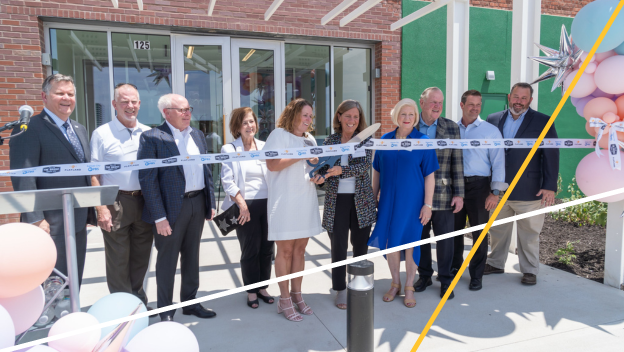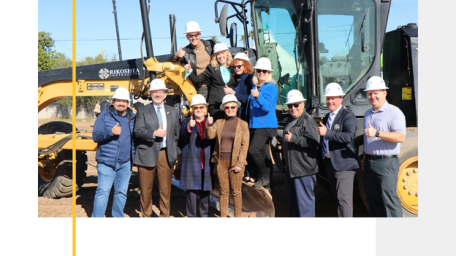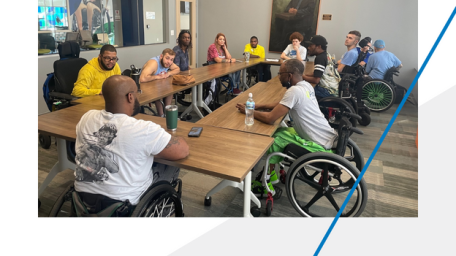Kansas City PBS Leverages NMTCs to Expand Community Living Room and Boost Programming for the Lifelong Learner

The New Markets Tax Credit is a federal funding program administered through the Community Development Financial Institutions Fund, a division of the U.S. Department of the Treasury. Enterprise Financial CDE is a community development entity that uses NMTC allocation to partner with businesses and community service providers committed to investing in eligible, highly distressed communities to improve economic development and quality of life for residents of underserved populations and low-income communities.
Kansas City PBS
St. Louis, Mo.
Investment Date:
2022
EFCDE’s NMTC Investment:
$12 million; total project: $16.5 million
Use of Funds:
Facility expansion and infrastructure upgrades to support community outreach, free cradle-to-grave education, civic engagement and investigative journalism
Outcomes:
100 quality construction jobs created, and more than 1.1 million residents served monthly through programmatic and infrastructure enhancements
There’s nothing that expresses the value of community more than inviting neighbors into your home. That was just one goal achieved when Kansas City PBS embarked on its comprehensive renovation and expansion of its headquarters in Kansas City, Missouri, thanks in great part to funding with New Markets Tax Credits (NMTCs), made available through Enterprise Financial CDE’s tax credit allocation. The building opened to the public in August 2023.
The renovated facility features an outdoor events plaza and expanded indoor gathering space — appropriately called The Living Room — to host educational events for all ages, like parenting classes, workforce training workshops and learning labs.
The station’s commitment to community, impactful journalism and local issues have also given what Kliff Kuehl, President and CEO of KCPBS, describes as a “trusted convener” role. The building expansion furthers a key strategy to foster local participation in civic affairs by bringing together its diverse residents and facilitating dialogue on social topics, such as mental health, houselessness and food insecurity.
Public Broadcasting Stations like Kansas City PBS were created out of the Carnegie Commission on Educational Television, established in 1965, with a mission to serve the public. The charge was clear: Show us the community as it really is. For KCPBS, this means the station, “looks out the window, not in a mirror,” to define its identity, and relies on its citizen-led Community Advisory Board for input on issues important to neighbors, says Kuehl.
Facility expansion and efficiencies of the 50-year-old building in need of restoration and repair also enhance workspace for the documentarians, journalists and “makers” who bring the local stories to life, says Kuehl. Digital and technology improvements also expand the reach of programming and streaming capabilities to the diverse audiences Kansas City PBS serves across its 80-mile radius. “One of our strategic goals at KCPBS is to make our free programming accessible to all, through our building and our public media channels across multiple platforms, on air and online,” he adds. In addition to public television stations, KCPBS includes Flatland, its digital news source, and 90.9 The Bridge, an NPR radio station supporting local music.
Perhaps best known for its earliest and primary mission — educational programming — PBS stations were the first, and perhaps only, children’s television programming designed with a curriculum centered around state and national standards. Today, broadcast programming reflects a cradle-to-grave approach for the lifelong learner. The public network has four television broadcast stations: its original PBS channel with nationally syndicated programming; a second featuring documentaries; a third—Create—offering how-to’s, such as cooking and gardening; and a fourth, 24-7 kids’ channel. Expanding access to these free, on-air channels was important to the fourth-watched network station in the city, Kuehl says, especially given that much of the audience watches via antennae and may have limited access to broadband for other streaming alternatives.
The station’s educational programming extends well beyond the airwaves. Kansas City PBS is a leader in teacher education, hosting literacy workshops, tech conferences and partnering in career-focused programs, such as the Black and Veatch STEM Mentoring Program that encourages students to consider STEM careers and the field of engineering.
Other programs are held within neighborhoods and are intended for both education and community building. That’s why Kansas City PBS engages with other community partners — school districts, public libraries, Science City and the YMCA, for example, when hosting or participating in events. Kuehl notes that it’s important to meet people where they are, and that outreach into the communities “builds credibility and trust — a key step before expecting others to come into our spaces.” Its “In Your Neighborhood” initiative first launched just before the COVID-19 pandemic, uniting friends, family and neighbors in low-income communities to find educational resources and networks of support. When circumstances forced gatherings online, the station realized there were no more limitations on borders, and individuals were joining from as far away as Florida. Today, the free virtual four-week kindergarten readiness program is thriving and abounds with parent resources using its PBS Kids and Sesame Street materials.
"All programs are free and accessible to everyone; it’s the heart of what we do,” says Kuehl.
NMTCs are critical for community organizations like these: independent nonprofits that are entirely or largely dependent on government grant funding and/or private donations to fund operations and capital improvements. While expansion and renovation projects typically raise capital in private support, large gaps remain and must be overcome to complete the project as intended. Case in point: KCPBS in 2022 launched the public phase of its community engagement and fundraising campaign "Picture This," supported by generous private funders and private donations. But those funds alone were not enough to fully support project costs, according to Rolonda Saulsberry, KCPBS’ Chief Financial Officer. Subsidized NMTC financing helped reduce this funding gap and offset budget increases and rising construction costs while reducing the need for additional long-term senior debt.
“The Kansas City PBS project was the ideal NMTC investment,” says Rachel O’Grady, Assistant Vice President with Enterprise Financial CDE and a resident of Kansas City. “KCPBS plays an important role in our community and is a vital part of the physical revitalization of 31st Street, a highly distressed part of the city now seeing redevelopment.” The KC Streetcar's expansion plans propose a stop a block away from the renovated facility, O’Grady notes, broadening access to KCPBS’ facility through free transportation from a number of low-income and surrounding Kansas City neighborhoods.
Kuehl agrees on the building’s important role in its community, stating that the project helps share stories that matter and achieve KCPBS’ strategic goal to be an integral part of the community fabric.
To Enterprise Financial CDE, Kuehl adds, “thank you very much for all of the help. It’s really made our building be all it can be to help better serve our valued listeners, readers and viewers.”
To the Kansas City residents Kansas City PBS serves, he exclaims: “Welcome home!”


